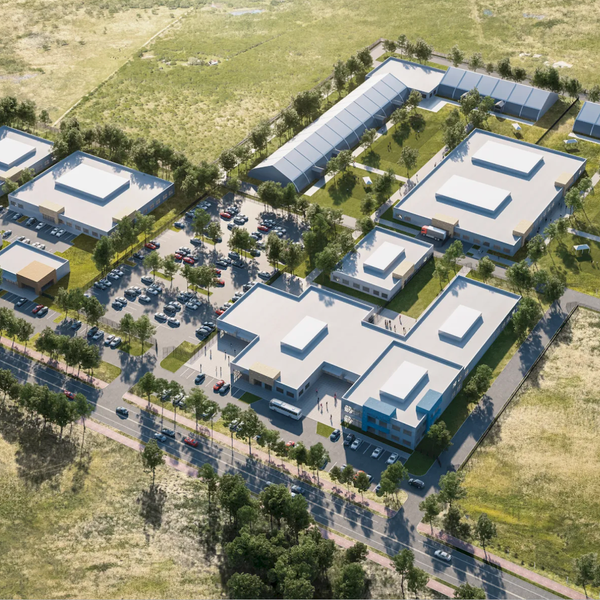Major Nuclear Dump Has Leaked, But Does US Gov't Have a Plan B?
Experts warn that troubled repository does not bode well for U.S. strategy for disposal of waste from nuclear weapons development

"This leak just proved that out of sight is not out of mind," said Arnie Gundersen, Chief Engineer and nuclear safety advocate at Fairewinds Associates and former nuclear industry executive turned whistleblower, in an interview with Common Dreams. "You can have a problem when you get this stuff underground, and then what do you do?"
The federally-owned Waste Isolation Pilot Plant (WIPP) in southeastern New Mexico, which stores nuclear waste deep beneath the earth's surface in salt formations, is the only underground repository for materials above the lowest level of radiation. It is the bedrock of the U.S. government's current approach to dispose of military-generated plutonium-contaminated transuranic waste from decades of nuclear bomb production and testing. Since it became operational in 1999, WIPP has collected this waste from across the United States, including Los Alamos National Laboratory in northern New Mexico.
The Department of Energy declares on their website that "WIPP has set the standard for safe, permanent disposal of long-lived radioactive defense wastes."
Yet, this standard has been called into question since a series of mishaps forced the facility to halt its operations. On February 5th, a vehicle caught on fire underground, forcing the evacuation of the facility and sending six workers to the hospital with smoke inhalation-related injuries. On February 14th, an alarm detected a suspected radiation leak which has since been confirmed to have released radioactive particles into the air.
The DOE and Nuclear Waste Partnership, the contractor that operates WIPP, admit that they do not yet know what caused the leak or what its health impacts will be. The DOE announced Wednesday that 13 workers tested positive for radiation, yet they say many more tests are needed and the number of people contaminated could rise.
At a packed town meeting in nearby Carlsbad earlier this week, residents expressed concern about the leak, with some vocalizing skepticism over WIPP officials' claims that radiation levels and health risks are low. New Mexico residents have long complained that WIPP, as well as nuclear waste transport across the state, puts local communities at risk, including the Native American reservations, school districts, and highways the waste passes through en route to the repository.
Meanwhile, the halt in WIPP operations is leaving waste stranded across the United States, "including the last of nearly 4,000 barrels of toxic waste that Los Alamos National Laboratories has been ordered to remove from its campus by the end of June," the Associated Press reports.
"This is a very significant failure," said Don Hancock, Director of the Nuclear Waste Program at the Southwest Research and Information Center, in an interview with Common Dreams. "Does this mean geologic repositories will never work? No. It just means they haven't worked yet."
Gundersen says that the U.S. government "does not really have a strategy" for safely disposing of the massive amount of nuclear waste that has already been generated, let alone the waste produced by current and future nuclear production. "The strategy is really just to put the waste wherever they can," he said.
"We've generated an enormous amount of waste already," added Gundersen. "It's like buying a house and having the carpenter promise to put in a toilet in 100 years. This has been the American policy approach."
_____________________
An Urgent Message From Our Co-Founder
Dear Common Dreams reader, The U.S. is on a fast track to authoritarianism like nothing I've ever seen. Meanwhile, corporate news outlets are utterly capitulating to Trump, twisting their coverage to avoid drawing his ire while lining up to stuff cash in his pockets. That's why I believe that Common Dreams is doing the best and most consequential reporting that we've ever done. Our small but mighty team is a progressive reporting powerhouse, covering the news every day that the corporate media never will. Our mission has always been simple: To inform. To inspire. And to ignite change for the common good. Now here's the key piece that I want all our readers to understand: None of this would be possible without your financial support. That's not just some fundraising cliche. It's the absolute and literal truth. We don't accept corporate advertising and never will. We don't have a paywall because we don't think people should be blocked from critical news based on their ability to pay. Everything we do is funded by the donations of readers like you. Will you donate now to help power the nonprofit, independent reporting of Common Dreams? Thank you for being a vital member of our community. Together, we can keep independent journalism alive when it’s needed most. - Craig Brown, Co-founder |

"This leak just proved that out of sight is not out of mind," said Arnie Gundersen, Chief Engineer and nuclear safety advocate at Fairewinds Associates and former nuclear industry executive turned whistleblower, in an interview with Common Dreams. "You can have a problem when you get this stuff underground, and then what do you do?"
The federally-owned Waste Isolation Pilot Plant (WIPP) in southeastern New Mexico, which stores nuclear waste deep beneath the earth's surface in salt formations, is the only underground repository for materials above the lowest level of radiation. It is the bedrock of the U.S. government's current approach to dispose of military-generated plutonium-contaminated transuranic waste from decades of nuclear bomb production and testing. Since it became operational in 1999, WIPP has collected this waste from across the United States, including Los Alamos National Laboratory in northern New Mexico.
The Department of Energy declares on their website that "WIPP has set the standard for safe, permanent disposal of long-lived radioactive defense wastes."
Yet, this standard has been called into question since a series of mishaps forced the facility to halt its operations. On February 5th, a vehicle caught on fire underground, forcing the evacuation of the facility and sending six workers to the hospital with smoke inhalation-related injuries. On February 14th, an alarm detected a suspected radiation leak which has since been confirmed to have released radioactive particles into the air.
The DOE and Nuclear Waste Partnership, the contractor that operates WIPP, admit that they do not yet know what caused the leak or what its health impacts will be. The DOE announced Wednesday that 13 workers tested positive for radiation, yet they say many more tests are needed and the number of people contaminated could rise.
At a packed town meeting in nearby Carlsbad earlier this week, residents expressed concern about the leak, with some vocalizing skepticism over WIPP officials' claims that radiation levels and health risks are low. New Mexico residents have long complained that WIPP, as well as nuclear waste transport across the state, puts local communities at risk, including the Native American reservations, school districts, and highways the waste passes through en route to the repository.
Meanwhile, the halt in WIPP operations is leaving waste stranded across the United States, "including the last of nearly 4,000 barrels of toxic waste that Los Alamos National Laboratories has been ordered to remove from its campus by the end of June," the Associated Press reports.
"This is a very significant failure," said Don Hancock, Director of the Nuclear Waste Program at the Southwest Research and Information Center, in an interview with Common Dreams. "Does this mean geologic repositories will never work? No. It just means they haven't worked yet."
Gundersen says that the U.S. government "does not really have a strategy" for safely disposing of the massive amount of nuclear waste that has already been generated, let alone the waste produced by current and future nuclear production. "The strategy is really just to put the waste wherever they can," he said.
"We've generated an enormous amount of waste already," added Gundersen. "It's like buying a house and having the carpenter promise to put in a toilet in 100 years. This has been the American policy approach."
_____________________

"This leak just proved that out of sight is not out of mind," said Arnie Gundersen, Chief Engineer and nuclear safety advocate at Fairewinds Associates and former nuclear industry executive turned whistleblower, in an interview with Common Dreams. "You can have a problem when you get this stuff underground, and then what do you do?"
The federally-owned Waste Isolation Pilot Plant (WIPP) in southeastern New Mexico, which stores nuclear waste deep beneath the earth's surface in salt formations, is the only underground repository for materials above the lowest level of radiation. It is the bedrock of the U.S. government's current approach to dispose of military-generated plutonium-contaminated transuranic waste from decades of nuclear bomb production and testing. Since it became operational in 1999, WIPP has collected this waste from across the United States, including Los Alamos National Laboratory in northern New Mexico.
The Department of Energy declares on their website that "WIPP has set the standard for safe, permanent disposal of long-lived radioactive defense wastes."
Yet, this standard has been called into question since a series of mishaps forced the facility to halt its operations. On February 5th, a vehicle caught on fire underground, forcing the evacuation of the facility and sending six workers to the hospital with smoke inhalation-related injuries. On February 14th, an alarm detected a suspected radiation leak which has since been confirmed to have released radioactive particles into the air.
The DOE and Nuclear Waste Partnership, the contractor that operates WIPP, admit that they do not yet know what caused the leak or what its health impacts will be. The DOE announced Wednesday that 13 workers tested positive for radiation, yet they say many more tests are needed and the number of people contaminated could rise.
At a packed town meeting in nearby Carlsbad earlier this week, residents expressed concern about the leak, with some vocalizing skepticism over WIPP officials' claims that radiation levels and health risks are low. New Mexico residents have long complained that WIPP, as well as nuclear waste transport across the state, puts local communities at risk, including the Native American reservations, school districts, and highways the waste passes through en route to the repository.
Meanwhile, the halt in WIPP operations is leaving waste stranded across the United States, "including the last of nearly 4,000 barrels of toxic waste that Los Alamos National Laboratories has been ordered to remove from its campus by the end of June," the Associated Press reports.
"This is a very significant failure," said Don Hancock, Director of the Nuclear Waste Program at the Southwest Research and Information Center, in an interview with Common Dreams. "Does this mean geologic repositories will never work? No. It just means they haven't worked yet."
Gundersen says that the U.S. government "does not really have a strategy" for safely disposing of the massive amount of nuclear waste that has already been generated, let alone the waste produced by current and future nuclear production. "The strategy is really just to put the waste wherever they can," he said.
"We've generated an enormous amount of waste already," added Gundersen. "It's like buying a house and having the carpenter promise to put in a toilet in 100 years. This has been the American policy approach."
_____________________

